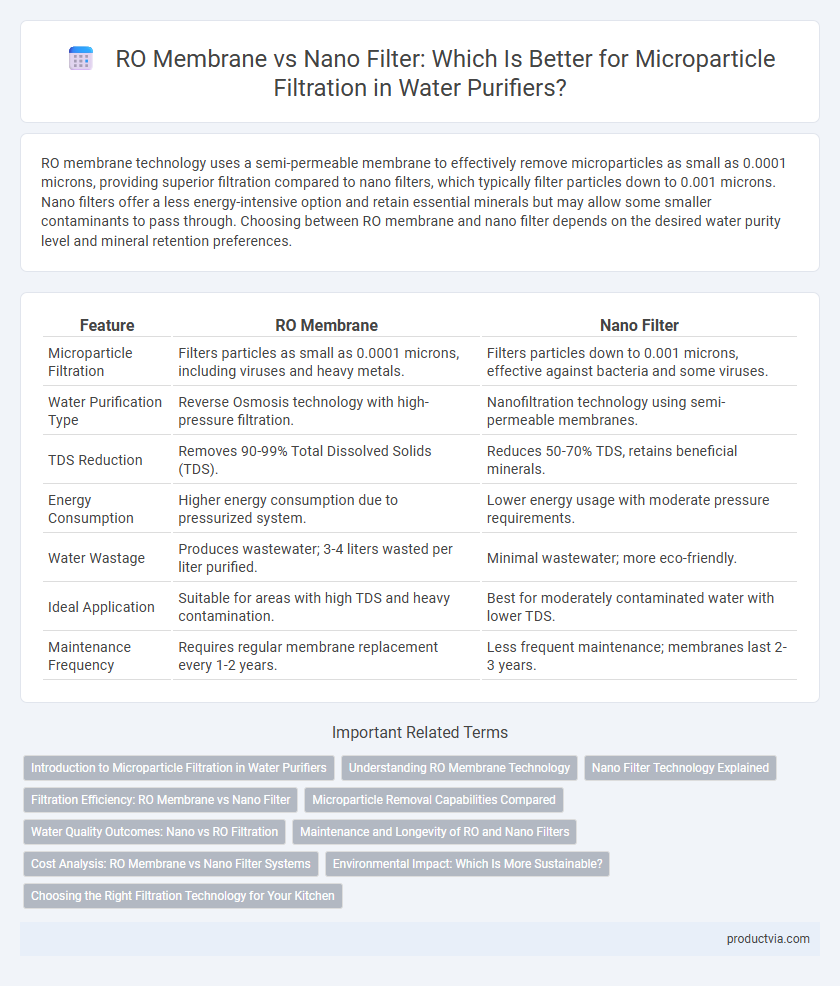RO membrane technology uses a semi-permeable membrane to effectively remove microparticles as small as 0.0001 microns, providing superior filtration compared to nano filters, which typically filter particles down to 0.001 microns. Nano filters offer a less energy-intensive option and retain essential minerals but may allow some smaller contaminants to pass through. Choosing between RO membrane and nano filter depends on the desired water purity level and mineral retention preferences.
Table of Comparison
| Feature | RO Membrane | Nano Filter |
|---|---|---|
| Microparticle Filtration | Filters particles as small as 0.0001 microns, including viruses and heavy metals. | Filters particles down to 0.001 microns, effective against bacteria and some viruses. |
| Water Purification Type | Reverse Osmosis technology with high-pressure filtration. | Nanofiltration technology using semi-permeable membranes. |
| TDS Reduction | Removes 90-99% Total Dissolved Solids (TDS). | Reduces 50-70% TDS, retains beneficial minerals. |
| Energy Consumption | Higher energy consumption due to pressurized system. | Lower energy usage with moderate pressure requirements. |
| Water Wastage | Produces wastewater; 3-4 liters wasted per liter purified. | Minimal wastewater; more eco-friendly. |
| Ideal Application | Suitable for areas with high TDS and heavy contamination. | Best for moderately contaminated water with lower TDS. |
| Maintenance Frequency | Requires regular membrane replacement every 1-2 years. | Less frequent maintenance; membranes last 2-3 years. |
Introduction to Microparticle Filtration in Water Purifiers
RO membranes offer highly effective microparticle filtration by removing particles as small as 0.0001 microns, including viruses and bacteria, making them ideal for comprehensive water purification. Nano filters typically filter particles around 0.001 microns, targeting contaminants such as heavy metals, chlorine, and organic compounds while retaining essential minerals. Understanding these distinctions helps in selecting the appropriate technology based on specific water quality needs and filtration goals.
Understanding RO Membrane Technology
RO membrane technology utilizes a semi-permeable membrane with pore sizes typically around 0.0001 microns, effectively removing microparticles, dissolved salts, bacteria, and viruses from water. Nano filters have larger pore sizes, about 0.001 microns, targeting contaminants like organic molecules and some pathogens but are less effective against dissolved ions and smaller microparticles. Understanding the molecular-level filtration of RO membranes highlights their superior capability for producing highly purified water compared to nano filtration.
Nano Filter Technology Explained
Nano filter technology utilizes membranes with pore sizes typically between 1 to 10 nanometers, effectively removing microparticles, bacteria, viruses, and organic contaminants while retaining essential minerals. Compared to RO membranes, nano filters operate at lower pressure, consume less energy, and prevent wastewater generation, making them more eco-friendly and cost-efficient for household water purification. This advanced filtration method ensures cleaner, healthier drinking water by targeting contaminants that standard filters might miss, without stripping beneficial minerals.
Filtration Efficiency: RO Membrane vs Nano Filter
RO membranes offer superior filtration efficiency by removing up to 99% of microparticles, including dissolved salts, heavy metals, and pathogens, making them highly effective for producing ultrapure water. Nano filters, with pore sizes typically around 1-10 nanometers, efficiently filter out larger microparticles, bacteria, and some viruses but are less effective against dissolved ions and smaller contaminants compared to RO membranes. The choice between RO membranes and nano filters depends on the required water purity level, with RO membranes preferred for comprehensive microparticle and ion rejection.
Microparticle Removal Capabilities Compared
RO membranes remove microparticles as small as 0.0001 microns, providing superior filtration by eliminating viruses, bacteria, and dissolved solids. Nano filters typically filter particles down to 0.001 microns, effectively removing bacteria and some viruses but allowing smaller dissolved substances to pass. For stringent microparticle removal, RO membranes offer more comprehensive purification compared to nano filters.
Water Quality Outcomes: Nano vs RO Filtration
RO membranes effectively remove up to 99% of microparticles, heavy metals, and dissolved salts, resulting in superior water purity and improved taste. Nano filters target larger microparticles and bacteria but are less efficient in eliminating dissolved contaminants and heavy metals, offering moderate water quality enhancement. For consumers prioritizing comprehensive contaminant removal and optimal water quality, RO filtration outperforms nano filtration in delivering safer, cleaner drinking water.
Maintenance and Longevity of RO and Nano Filters
RO membranes require regular maintenance to prevent clogging and scaling, typically needing replacement every 2-3 years to ensure optimal microparticle filtration. Nano filters generally have longer lifespans, often lasting 3-5 years, with less frequent maintenance due to their larger pore size and reduced susceptibility to fouling. Proper upkeep of both filter types enhances durability, but nano filters offer a balance of efficiency and ease of maintenance for sustained microparticle removal.
Cost Analysis: RO Membrane vs Nano Filter Systems
RO membranes generally incur higher initial costs and maintenance expenses compared to nano filters due to their complex filtration technology and frequent replacement needs. Nano filter systems offer a cost-effective alternative for microparticle filtration with lower energy consumption and longer filter lifespan, reducing operational expenses over time. Evaluating total cost of ownership, nano filters present a more budget-friendly solution for households and small-scale applications, while RO membranes suit higher purity requirements despite the increased financial investment.
Environmental Impact: Which Is More Sustainable?
RO membranes generate more wastewater during filtration, increasing water resource depletion compared to nano filters, which offer higher water recovery rates and less environmental strain. Nano filters consume less energy because of lower pressure requirements, reducing carbon emissions associated with water purification processes. The biodegradable nature of nano filter materials also contributes to reduced landfill waste, making them a more sustainable choice for microparticle filtration in eco-conscious settings.
Choosing the Right Filtration Technology for Your Kitchen
RO membranes provide superior microparticle filtration by removing contaminants as small as 0.0001 microns, ensuring highly purified water. Nano filters typically filter particles down to 0.01 microns and are more effective against bacteria and viruses while preserving essential minerals. Selecting between RO membranes and nano filters depends on water quality, desired purity level, and mineral retention preferences for your kitchen water purification system.
RO Membrane vs Nano Filter for microparticle filtration Infographic

 productvia.com
productvia.com